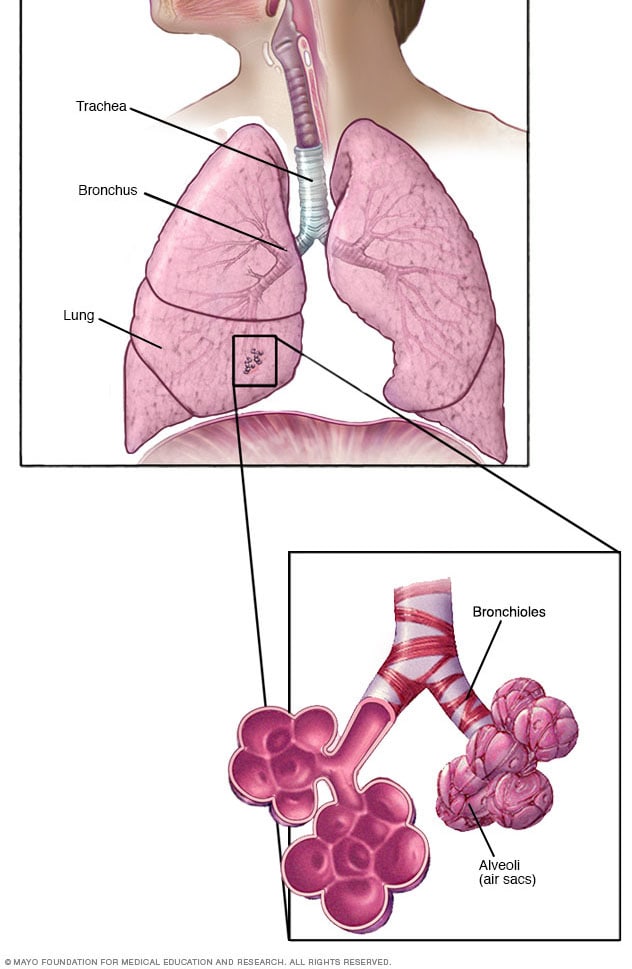Overview
Pneumonitis (noo-moe-NIE-tis) is a general term that refers to swelling and irritation, also called inflammation, of lung tissue. Lung infections such as pneumonia also can cause lung tissue to become inflamed. But pneumonitis generally refers to inflamed lung tissue not caused by an infection.
Pneumonitis is a result of an extra strong defense response by the body's immune system to an irritating substance. Common causes of pneumonitis include airborne irritants at a job, in the home or from hobbies. Other causes include some cancer treatments and many different medicines.
Trouble breathing, and often a dry cough, are the most common symptoms of pneumonitis. Treatment focuses on avoiding irritants and lessening the inflammation of lung tissue.
Products & Services
Symptoms
Symptoms of pneumonitis may develop quickly or slowly and can worsen over time. At times symptoms may suddenly get worse or better. Also, symptoms vary greatly among people with the condition and include:
- Trouble breathing.
- Dry cough that usually doesn't bring up any mucus.
- Extreme tiredness.
- Loss of appetite.
- Fever.
- Joint and muscle pain.
- Headache.
- Weight loss.
When to call a doctor
Talk to your doctor or other healthcare professional if you notice symptoms such as trouble catching your breath or an ongoing dry cough.
If you have trouble breathing, go to the emergency department at a hospital right away or, in the U.S., call 911.
Causes
Bronchioles and alveoli in the lungs

Bronchioles and alveoli in the lungs
In your lungs, the main airways, called bronchi, branch off into smaller and smaller passageways. The smallest airways, called bronchioles, lead to tiny air sacs called alveoli.
Pneumonitis happens when an irritating substance causes inflammation in the tiny air sacs called alveoli in your lungs. Inflamed lung tissue makes it hard for oxygen to pass through the alveoli into the bloodstream.
Many causes have been linked to pneumonitis. But it's not clear why some people have a strong immune system response to certain substances that cause pneumonitis, while others do not. For many people, the specific substance causing the inflammation is never identified.
Some types of pneumonitis include hypersensitivity pneumonitis, drug-induced pneumonitis and radiation-induced pneumonitis.
Hypersensitivity pneumonitis
For some people, breathing in airborne particles triggers a strong allergic reaction by their immune system. This reaction irritates the lungs, causing pneumonitis. The condition also is called extrinsic allergic alveolitis.
Specific types of hypersensitivity pneumonitis have nicknames related to their cause, such as "farmer's lung," "bird-fancier's lung" or "hot tub lung."
Causes can include:
- Molds. Repeated exposure to molds can cause inflamed lung tissue. Breathing in airborne bits from moldy hay is one of the most common causes of work-related pneumonitis. Moldy conditions in hot tubs also can cause pneumonitis because the bubbling action makes a mist containing mold. It's common for mold to grow in home humidifiers that aren't cleaned often. Other examples of humid places where mold can grow and be released into the air include air conditioners, swimming pools, water-damaged carpet and ventilations systems.
- Birds. Exposure to bird feathers, dust or droppings is a common cause of pneumonitis.
- Dust. Exposure to dust from metal work or hardwoods can cause pneumonitis.
- Chemicals. Aerosolized mists, chemicals and pesticides can irritate lungs and cause pneumonitis.
- Animal fur. Skin cells, fur and droppings from animals are another cause of pneumonitis. This may happen when working closely with cattle and in veterinary practices.
Drug-induced pneumonitis
Many medicines can cause pneumonitis. But the exact reason why certain medicines cause inflamed lung tissue isn't clear. It's possible that some medicines may irritate lung cells, and then the immune system has a strong response that causes inflammation.
Examples of medicines that may cause pneumonitis include certain antibiotics, many medicines used to treat cancer and some medicines that keep your heartbeat regular.
Radiation-induced pneumonitis
Some people who have radiation therapy to the chest, such as for breast or lung cancer, may get pneumonitis. Pneumonitis also can happen after whole-body radiation therapy that's done to prepare a person for a bone marrow transplant. Symptoms usually appear in the first few months after radiation treatment is finished.
Risk factors
Environment
Some factors cause a higher risk of pneumonitis, including:
- Jobs and hobbies. Farming raises exposure to mold particles that can be breathed in during harvests of grain and hay. Another risk factor is a job where workers are around fine mists, fumes, dust and chemicals. Woodworking may raise your risk too.
- Bird and animal handling. Poultry workers and people who breed or keep pigeons and other birds often are exposed to droppings, feathers and other materials that can cause pneumonitis. Being around a lot of animals also may raise your risk.
- Using hot tubs and humidifiers. Moldy conditions in hot tubs, home humidifiers that aren't cleaned often and anywhere else mold can grow are risk factors for pneumonitis.
Cancer treatment
Some medicines used to treat cancer can cause pneumonitis. So can radiation therapy to the lungs and chest. The combination of the two raises the risk of pneumonitis even more.
Genes
Genes may play a role in having an extra strong immune response to substances. If you have family members who have a strong allergic reaction to substances, you may have a higher risk of an allergic reaction as well.
Complications
If pneumonitis is not detected or not treated, you may gradually develop lung damage that can't be reversed.
In healthy lungs, the air sacs stretch and relax with each breath. Ongoing inflammation of the thin tissue lining each air sac causes scarring and makes the air sacs less flexible. They become stiff like a dried sponge. This is called pulmonary fibrosis. In severe cases, pulmonary fibrosis can cause high blood pressure in the lungs, right-sided heart failure, respiratory failure or death.